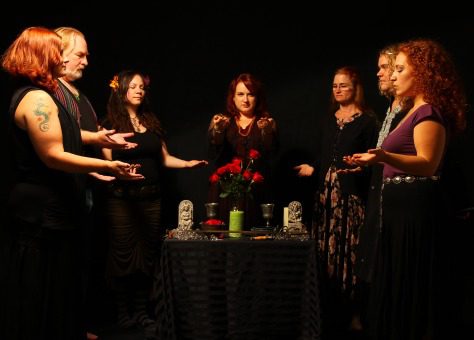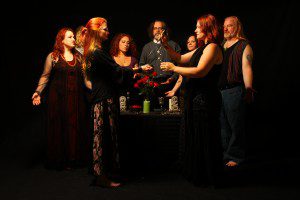 No matter where I’m at, I tend to see the same problems again and again when it comes to group ritual, especially large (over 15 people) rituals. Even people who have sold thousands of books occasionally stumble in public. Ritual is hard work, and it’s never easy. When you write ritual you are basically answering to three very different entities: yourself, the group you are writing for, and the gods/Earth. Satisfying all three of those things can be a challenge.
No matter where I’m at, I tend to see the same problems again and again when it comes to group ritual, especially large (over 15 people) rituals. Even people who have sold thousands of books occasionally stumble in public. Ritual is hard work, and it’s never easy. When you write ritual you are basically answering to three very different entities: yourself, the group you are writing for, and the gods/Earth. Satisfying all three of those things can be a challenge.
Answering to yourself means that the things in your ritual have to be true to what you believe. If you invoke the gods and don’t believe that it’s possible to invoke the gods it will show. Ritual should not be about empty and hollow gestures, everything you do should have purpose. In addition the things you (and those around you) say should represent your voice. If you aren’t a Druid and steal a bunch of verses from a Druidic ritual things aren’t going to feel right.
Writing ritual should never be about the gratification of your own ego, it should be about serving the spiritual needs of the people you are presenting it to. You might come up with the greatest Samhain ritual ever, but if many of the things people expect out of a Samhain ritual are missing you are going to completely puzzle and most likely let down your audience. Samhain is about the Final Harvest and reuniting with our beloved dead, leave both of those things out and you might not have a Samhain Ritual anymore. No matter how skillful you might be, you can’t just spring things out of the blue on people either. If your group does Wiccan-style rituals performing an Asatru Rite without any prior warning may not be the best idea.
 Ritual also requires us to answer to something bigger than ourselves, I generally think of that “bigger” as deity, but it could also be something more nebulous like “spirit” or “the Earth.” If you are performing a ritual dedicated to healing our planet, you might not want to use styrofoam cups during Cakes & Ale. In a similar vein, the middle of your Beltane rite is probably not the best time to call to the “Dread Lord of Shadows.” The deities you use should be consistent with what your ritual is about.
Ritual also requires us to answer to something bigger than ourselves, I generally think of that “bigger” as deity, but it could also be something more nebulous like “spirit” or “the Earth.” If you are performing a ritual dedicated to healing our planet, you might not want to use styrofoam cups during Cakes & Ale. In a similar vein, the middle of your Beltane rite is probably not the best time to call to the “Dread Lord of Shadows.” The deities you use should be consistent with what your ritual is about.
Figuring out the accountability aspects of ritual helps to determine a lot of things in the ritual writing process. You’ll have an idea of what deities you are calling to, and what sort of format your rite will adhere to (ADF Druid? Eclectic Pagan? British Traditional Witch? Hellenic? etc.). The general expectations of a sabbat go a long way into determining a ritual’s theme as well. If you want to play into the general themes of Imbolc for instance you might do a ceremony welcoming back the light along with another activity to honor the Celtic Goddess Bridgit.

One of the first things I do when sitting down to write ritual is to formulate a Statement of Intent. What we say matters, and what we say at the beginning of ritual often sets the tone for all that follows. Speech also has a way of helping to make things manifest, if you don’t articulate what you want to happen, it probably won’t happen. A good SoI encapsulates a ritual, setting the stage for all that follows. When I’m writing a ritual, it also serves as a good check-point because I want everything I do to revolve around that one idea. This was my SoI last Samhain:
“We gather here tonight to celebrate the passing of the Old Year and to welcome in the new. We are here to celebrate Samhain, the final harvest, that time when the veil between the world’s is at its thinnest and those that have departed this world may return to it once more. We journey this sacred night to the edge of the Summerlands to honor our ancestors and our dearly departed dead. So mote it be.”
Everything in that ritual revolved around those words, and when something didn’t come back to my SoI, I threw it out.
Rituals should generally take between 45 and 70 minutes. Anything under 45 minutes is probably too short, and anything over 70 minutes runs the risk of being too long. There are exceptions to these rules, if your intimate circle prefers long ritual, good for you all, you shouldn’t stop doing it on my account (and this post is mostly about large group ritual anyways). There’s a sweet-spot there in the middle and it’s one I generally recommend. Sometimes rituals are just going to run long, which is fine as long as people are completely engaged through the entire ritual’s run.
 Speaking of long rituals, a great ritual presenter knows when to adapt if (and when) circumstances change. Several years ago I went to a very large (70 people plus) ritual presented by a chaos magician. The opening of the ritual had the High Priest challenge everyone who walked through the door, and each challenge took about a minute. That would have been fine if the ritual only had fifteen attendees, but it had over seventy, so before anything even truly started the ritual had already lasted over an hour! That’s poor planning; you’ve got to adapt in such instances. (This particular example sticks out in my mind because I was one of the first to be challenged and enter ritual space, where my bladder immediately decided it needed to be emptied. Needless to say I was doing the “pee-pee dance” for the next two hours.)
Speaking of long rituals, a great ritual presenter knows when to adapt if (and when) circumstances change. Several years ago I went to a very large (70 people plus) ritual presented by a chaos magician. The opening of the ritual had the High Priest challenge everyone who walked through the door, and each challenge took about a minute. That would have been fine if the ritual only had fifteen attendees, but it had over seventy, so before anything even truly started the ritual had already lasted over an hour! That’s poor planning; you’ve got to adapt in such instances. (This particular example sticks out in my mind because I was one of the first to be challenged and enter ritual space, where my bladder immediately decided it needed to be emptied. Needless to say I was doing the “pee-pee dance” for the next two hours.)
Adaptation should also take into account dealings with cast members who don’t show up to your ritual. With only a few small exceptions (generally the role of High Priestess) I try to write all of my rituals in such a way that I (or someone else) could substitute myself in at the last moment if someone forgot to show up. If your ritual is overly reliant on drummers and your drummers don’t show up you are completely screwed, so you’ve got to have a plan of ritual attack which takes that into consideration. There are always a few people we can trust to show up prepared and on time, but there are sometimes many more folks who will abuse that trust, be prepared no matter what the circumstances.
The most difficult part of any ritual is figuring out what to put in the middle. I’m not saying that writing quarter calls and Goddess invocations is easy, just that there’s at least a lot of precedent that can be called upon when dealing with those parts of a ritual. The “meat” of a rite is what people are most likely to take with them, so it deserves a lot of thought. Coming up with something original or different here is also challenging, but if you stick with at least a few of my suggestions below you should be in good shape.
 Ritual should be tactile and it should engage (and indulge) as many of the senses as possible. Whatever you are doing should look good. If you are trying to make an impression on a large group of people you should dress the part. You don’t necessarily have to wear a robe or wander around skyclad, but how you look should be different than how you generally look day to day. Incense puts many people in ritual head space the moment they smell it, using smoke, an oil diffuser, or a scented candle can make a big difference. People often forget that sound can also go a long way in a rite. Starting things off with just the right chant or language (“I summon stir and call you up!”) helps to set a mood that can last the entirety of a ritual.
Ritual should be tactile and it should engage (and indulge) as many of the senses as possible. Whatever you are doing should look good. If you are trying to make an impression on a large group of people you should dress the part. You don’t necessarily have to wear a robe or wander around skyclad, but how you look should be different than how you generally look day to day. Incense puts many people in ritual head space the moment they smell it, using smoke, an oil diffuser, or a scented candle can make a big difference. People often forget that sound can also go a long way in a rite. Starting things off with just the right chant or language (“I summon stir and call you up!”) helps to set a mood that can last the entirety of a ritual.
I was recently handed a ritual script that called for the High Priest to take a corn dolly around the circle so others could put their energy into it. No one else would be allowed to hold the corn dolly, just project energy into it . . . . . bad bad bad! People want to touch stuff, they want to feel things, they want to connect with whatever is going on in ritual. You can make that easier to do by providing physical objects for people to grasp. Instead of putting energy into something, have people write what they want to get rid of on a piece of paper, or allow them to project it into an object they can hold in their hands . . . . and then pass around the corn dolly allowing people to attach those things to it. We experience ritual with both our heads and our bodies, make sure both parts of the self are involved in what’s going on.
Resist the urge to make your ritual too talky. It’s great that you’ve come up with the greatest dialogue this side of Citizen Kane but ten minutes of standing around watching you talk is probably not going to cut it for everyone else. A few minutes of dialogue while your High Priestess is Drawing Down the Moon and everyone in the room can feel the energy build is great, eight minutes of you engaged in a private play that the rest of us can only observe rarely works. I was standing next to a High Priestess I know recently and she made just such an observation during a ritual we attended together. “I’ll be glad when we are done with this play and can get back to real ritual the next time we meet,” she said. Ouch!
 Remember, the ritual is not just for you, it’s also for everyone who has gathered. The entire circle should feel like they are involved in some way, because if they aren’t, they might as well be watching a play. Ritual should provide everyone with a moment, something that brings everyone into the rite. A guided meditation doesn’t bring everyone in, it creates a bunch of different worlds where we aren’t interacting with each other and sometimes the ritual its self! Ritual should always provide moments where everyone interacts with that Statement of Intent you articulated at the beginning of your rite.
Remember, the ritual is not just for you, it’s also for everyone who has gathered. The entire circle should feel like they are involved in some way, because if they aren’t, they might as well be watching a play. Ritual should provide everyone with a moment, something that brings everyone into the rite. A guided meditation doesn’t bring everyone in, it creates a bunch of different worlds where we aren’t interacting with each other and sometimes the ritual its self! Ritual should always provide moments where everyone interacts with that Statement of Intent you articulated at the beginning of your rite.
It’s important to practice before presenting a ritual, but preparation isn’t the only thing. You can hit every mark and wear the greatest costumes known to humankind, but if your ritual lacks a spiritual component it’s going to leave many folks cold. Ritual should allow us to connect with something greater than ourselves. That doesn’t mean you have to draw down the Goddess and God or usher in the spirits of the ancestors at every ritual, there are many ways to connect with that something greater. I want to connect with the Wheel of the Year and try to figure out where we all stand in the middle of Gaia’s cosmic puzzle. The journeys of the sun and moon are my journeys too, and I want to feel the strands that connect me to them.
Going over a Samhain ritual recently I came to the moment in the ritual where the gates were to be opened and the souls of the dead were invited to return to us. The intention of the ritual-writer was dead-on, but the execution didn’t give anyone in the circle the opportunity to interact with those spirits. At Samhain I want to say the names of my grand-parents (Grandma! Gramps!) and my cat (Princess!), I want to do something that remembers them and gives me a moment to linger with their spirits. I don’t think we generally want twenty-five soliloquies during ritual, but everyone should be provided with that moment, and that opportunity to feel connection to forces greater than ourselves. It doesn’t have to last an excessively long time, but it should be long enough to say a name or feel a presence.
 In order to do all of the things outlined above, ritual has to be interactive. My general rule of thumb is a minimum of two activities per ritual that allow us to connect or feel something magical. In smaller rituals I’ve had everyone in my circle reflect on the word “Witch” and what it means to us. You’d be surprised at how empowering such small moments can be. Art projects and crafts work well here too (they often indulge all the senses!), and what is dance and chant if not an interactive experience!?
In order to do all of the things outlined above, ritual has to be interactive. My general rule of thumb is a minimum of two activities per ritual that allow us to connect or feel something magical. In smaller rituals I’ve had everyone in my circle reflect on the word “Witch” and what it means to us. You’d be surprised at how empowering such small moments can be. Art projects and crafts work well here too (they often indulge all the senses!), and what is dance and chant if not an interactive experience!?
One last bit of advice, keep your expectations for ritual reasonable. I have a friend who is convinced that rituals should turn always turn into Dickensian revels with her right in the middle, and it’s completely unrealistic. You can’t control behavior and you should never rely on the people witnessing and experiencing your rite to come in and then play a huge role. People want moments, but they also don’t want the spotlight shining down on them during someone else’s ritual. It can be hard to figure out the balance there, but anything that puts someone on the spot is probably a bad idea.
I’ve always found writing group ritual to be a challenge, but when it works the pay-off is worth all the blood, sweat, and tears. When you feel your circle-mates engaged in something beyond themselves, and you’ve felt the consciousness of the room shift just a little . . . . those are the moments I live for. Seeing the circle once you’ve turned the lights back on, and then being able to witness the exhaustion, exhilaration, and pure emotion on their faces . . . it’s a Wow! moment and makes all the hours spent writing ritual feel well spent. So mote it be!
If you want bigger versions of the pictures, just click on them. You’ll get to see my ugly mug in super clear resolution and embiggened (as Jebediah Springfield would say).
A few Raise the Horns rituals from postings past:
Samhain
Yule
Imbolc
Beltane
Mabon

















